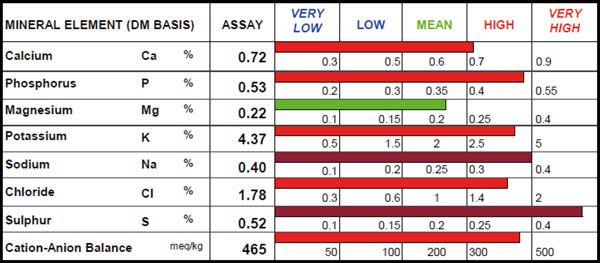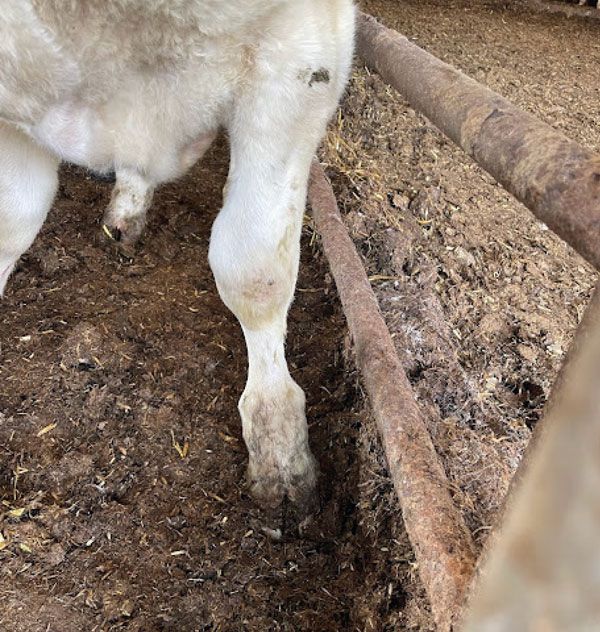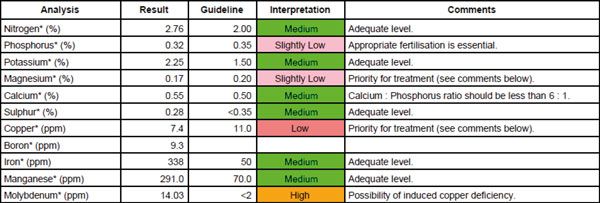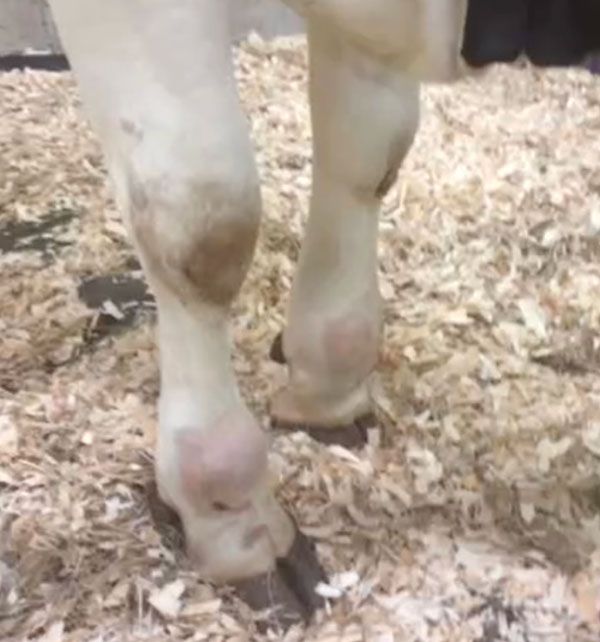UCD Research - September 2023
UCD Herd Health Team clinical research update
In this article, Assistant Professor Eoin Ryan highlights a small selection of the many herd health problems that the UCD Herd Health Team has been encountering and documenting in recent years
In association with


Assistant Professor Eoin Ryan
MVB MVM, DipECBHM
Trace element toxicities
Sulphur toxicity
One of the toxicities that has been identified as a cause of problems on many farms is sulphur toxicity. Sulphur toxicity can cause clinical symptoms essentially similar to classic cerecrocortical necrosis (CCN), as it too leads to polioencephalomalacia (PEM). In our investigations, we have identified it as a cause of neurological disease in adult dairy cows, as well as young calves at grass with persistent CCN-like signs. Cattle with sulphur toxicity and PEM have normal ruminal and blood thiamine concentrations, and brain levels may even be elevated. In contrast, brain thiamine pyrophosphate enzyme (TPP) is decreased in high-sulphur diet–associated PEM cases.

Figure 1: Grass mineral analysis showing sulphur concentration of 0.52 per cent (target is <0.3 per cent).
This would suggest that high dietary sulphur either increases the metabolic demand for, or inhibits the synthesis of, TPP and when sufficiently low levels of the enzyme occur in the brain, CCN/PEM may develop (Peek and Divers, 2018). In terms of risk factors, it has been shown that sulphur concentrations increase dramatically in grass after a period of drought, as has occurred in many summers over the last number of years. This, together with an increase in high sulphur fertiliser use, has likely led to the increase in prevalence of this disease. The treatment is the same as for classic CCN, resulting from thiamine deficiency, but the response to treatment is often poor as it can take some time for active TPP enzyme levels to return.
In our experience, there are many pastures around the country that have very high sulphur concentrations, in excess of 0.3 per cent. On some farms, we have encountered grass sulphur concentrations as high as 0.58 per cent. It is an additional reason that we would strongly recommend that all farms should carry out silage mineral and trace element analysis on an annual basis, and grass mineral (Figure 1) and trace element testing if there are clinical signs consistent with multiple episodes of CCN-like symptoms at grass. So many common trace element deficiencies, toxicities and metabolic problems can be anticipated if vets are supplied with this information each year.
The UCD Herd Health Team
The UCD Herd Health Team continues to provide a consultancy herd health service to veterinary practitioners around the country, whether through direct consultancy over the phone, indirect via email or via on-farm herd health problem investigations. The UCD Herd Health Team is made up of a team of European specialists, together with residents undergoing specialist training: Dr Finnian Logan, ECBHM specialist and Dr Eilidh Thomson, ECAR specialist. The team that primarily delivers herd health problem investigations includes:
- three European specialists in bovine health management: Dr Eoin Ryan, Dr Catherine McAloon and Dr Conor McAloon;
- two European specialists in animal reproduction: Dr. Marijke Beltman and Dr Emmet Kelly; and,
- a European specialist in animal nutrition, Dr Finbar Mulligan.
- Additional team members include: Professor Michael Doherty, ECBHM specialist; Professor Simon More, ECBHM specialist; Dr Luke O’Grady, ECBHM specialist; and Professor Mark Crowe, ECAR specialist. This consultancy service is provided in addition to the primary clinical teaching service in the UCD Farm Animal Hospital.
Members of the UCD Herd Health Team have carried out herd health problem solving investigations in every county on the island of Ireland over the last 10 years, providing support and guidance for veterinary practitioners, valuable experiential training for UCD’s veterinary residents, herd health teaching for its students, and help in driving clinical research within the herd health and husbandry section of the Vet School. In addition to allowing the Vet School to support the farm animal veterinary profession in Ireland, herd health problem-solving affords the added privilege of being able to collaborate on investigations with colleagues in the Regional Veterinary Laboratories, Teagasc and Animal Health Ireland.
Thiomolybdate toxicity
Thiomolybdate toxicity still remains a common cause of ill-thrift and poor coat colour in young calves at grass, either suckler or dairy. In this case, high levels of molybdenum, sulphur and/or iron in grass is leading to the formation of thiomolybdate complexes in the rumen of grazing animals which then bind up copper resulting in many signs commonly associated with classical primary copper deficiency. As part of this toxicity, the thiomolybdates also decrease the function of copper-containing enzymes in the blood and around the body, including ceruloplasmin. Other clinical signs which we have also commonly seen attributable to this problem include physitis (Figure 2) and diarrhoea in young calves at grass. In many cases, the physitis can be very marked leading to stiffness or lameness.
In some herds, fertility performance can be negatively affected via reduced conception rates. Diagnosis can be made using grass mineral and trace element testing with risk factors including: a copper to molybdenum ratio <3:1; sulphur concentrations >0.3 per cent; and iron to copper ratios of >50:1. Diagnosis can be confirmed via: blood testing for ceruloplasmin to copper ratio; serum/plasma superoxide dismutase concentrations; and by assessing liver and blood copper levels to assess copper status and rule out primary deficiency. The use of ionised copper boluses, delivering sacrificial copper to the rumen, is a very useful way of preventing clinical signs in calves and cows and superior to copper oxide boluses.
Pasture management can be very important, especially in peaty soil where molybdenum concentrations can be >10mg/kg DM (Figure 3 overleaf). Soil aeration may help to reduce molybdenum concentrations and uptake by grass. However, it must be noted that legumes like clover may actually increase the risk of thiomolybdate toxicity in high-risk pastures due to their deep root structures.

Figure 2: Photograph showing severe physitis in a three-month-old Charolais suckler calf with thiomolybdate toxicity and blood copper of 0.6µmol/L (Normal range 9.5 to 17.5µmol/L).
Poor Fertility Performance
In addition to mastitis and high SCC problems, one of the most common herd health problems that we investigate routinely is that of poor fertility performance. Over the last 10-15 years, we have noted a significant reduction in issues primarily driven by submission rate or poor heat detection. Simultaneously, we have seen a rise in the proportion of fertility problems driven by poor conception rates.
In dairy herds, it remains a consistent finding that we can trace poor conception rates in the months of May and June back to negative energy balance (NEB) problems that occurred in February to April. As oocytes are matured and prepared for the oestrus cycle approximately six to eight weeks in advance, there is no doubt that NEB in March and April will lead to poor oocyte quality in those oocytes involved in follicular waves and ovulation later in May and June.
Looking back at milk solids data, either individual cow or bulk milk data, can be very informative when trying to explain poor conception rates in herds where AI technique and heat detection appear to be well done, and there is a solid vaccination programme in place reducing the risk of infectious disease. If looking at bulk milk data, e.g., on the ICBF Co-op Performance Report or from farmer related data, a good target for bulk milk protein percentage is >3.2 per cent for a traditional British or Holstein-Friesian herd. If bulk milk protein drops below 3.2 per cent, this is a reasonable indicator that there was likely some NEB in the herd at this time. Similarly, if bulk milk fat to protein ratio is ≥1.4, then that is also a suggestion that there was excessive mobilisation of body fat and a risk of NEB or subclinical ketosis at that time.
In the case of individual cow milk recording data, the ICBF Milk Recording Farm Summary Report can be very useful with similar target values for average milk protein percentage and fat to protein ratios across the lactation groups. Alternatively, a detailed examination of individual cow milk protein percentage, using a cut-off of <3.04 per cent as indicative of a low milk protein percentage, can highlight a problem of NEB if >15 per cent of the herd or group assessed have low milk protein percentage. There is no doubt that metabolic diseases, e.g., subclinical hypocalcaemia, excessive BCS at calving, BCS loss post-calving, and NEB/ketosis, are significant contributors to poor conception rates in many Irish dairy herds.

Figure 3: Grass Trace Element Analysis showing extremely High Molybdenum concentrations.
Mycoplasma bovis outbreaks
There have been many Mycoplasma bovis outbreaks in 2023 and the epidemiology has followed similar patterns to previous years. Essentially outbreaks are triggered by immunosuppression or stress in herds. In dairy herds, the main triggers for Mycoplasma bovis outbreaks are high stocking density and NEB in the periparturient period. Prevention of periparturient metabolic disease via optimal BCS management, minimisation of the risk of hypocalcaemia, and optimal post-partum nutritional management, also serves to minimise the risk of Mycoplasma bovis outbreaks in dairy herds. Research carried out by Dr Catherine McAloon (McAloon et al, 2022) has shown that at least 45 per cent of Irish dairy herds were seropositive for Mycoplasma bovis antibodies in autumn 2018, confirming that this is a relatively endemic disease in Ireland.
As herd size has increased, we have seen a definite increase in Mycoplasma bovis outbreaks, manifesting as outbreaks of polyarthritis (Figure 4) or mastitis mainly in dairy herds. There is no doubt that a lack of adequate housing capacity contributes strongly to these outbreaks, facilitating direct nose-to-nose contact and easy transmission from shedding animals. As a result, all herds should be vigilant in relation to minimising periparturient immunosuppression, and farmers should be encouraged to match their stock numbers to the housing that is available for the winter months. In the face of an outbreak, it is always valuable to separate the affected animals and move them outdoors away from the main herd. Also, as soon as the main herd can be managed outdoors the better, as this reduces contact time and helps to break the transmission cycle. Interestingly, not all cases of polyarthritis require urgent culling as many can improve greatly from initial severe lameness to a milder lameness or subclinical lameness.
They should still be considered as high-risk carriers and, together with confirmed Mycoplasma bovis PCR positive mastitis cases, would usually be worth culling. An important strategy in the face of a Mycoplasma bovis mastitis outbreak that occurs early in lactation is drying off infected quarters – this will remove the source of infection and significantly reduce the risk from this cow. This, together with segregation (milking the problem cows last), can help control Mycoplasma bovis mastitis spread in the parlour if milking routine and post-milking teat disinfection are good. Having additional control measures such as an in-built cluster flush system in the milking machine can also be of huge benefit.

Figure 4: Cow with Mycoplasma bovis polyarthritis of the fetlock joints.
- Peek, S.F. and Divers, T.J. Rebhun’s Diseases of Dairy Cattle. (2018) Third Edition, Page 626.
- C. I. McAloon, C. G. McAloon, J. Tratalos, L. O’Grady, G. McGrath, M. Guelbenzu, D. A. Graham, K. O’Keeffe, D. J. Barrett, and S. J. More. Seroprevalence of Mycoplasma bovis in bulk milk samples in Irish dairy herds and risk factors associated with herd seropositive status. (2022) J. Dairy Sci. 105:5410–5419; https://doi.org/10.3168/jds.2021-21334.
In association with


Assistant Professor Eoin Ryan
MVB MVM, DipECBHM
















